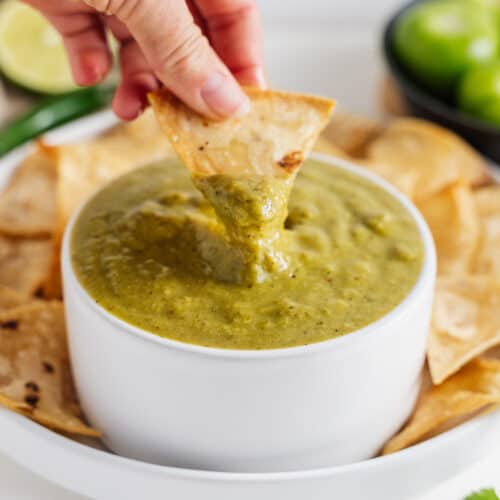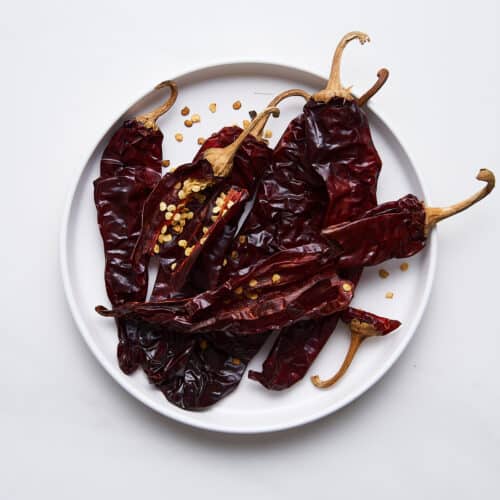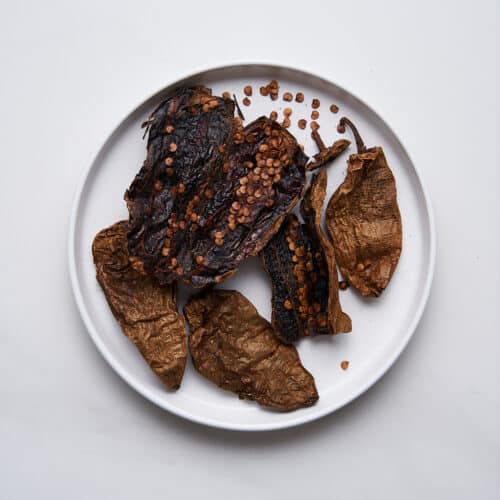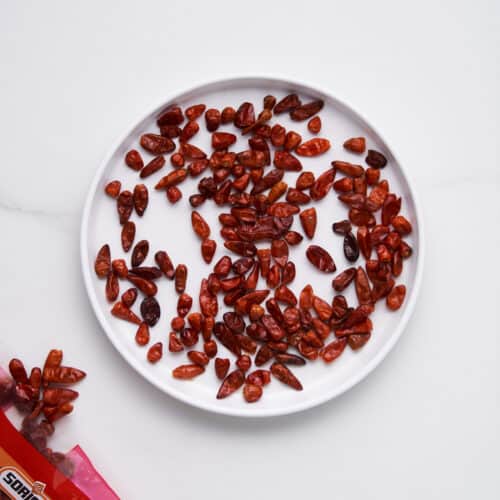Habanero Peppers
Habanero peppers are much more than an extremely spicy chile! Thanks to its citrus and floral notes, this flavor-packed chile complements a variety of dishes. Learn everything you need to know, including how to roast, peel, and seed them.

What are habanero peppers?
What used to be dubbed the world’s hottest pepper, the chile habanero is a top choice for spice lovers. Habanero peppers belong to the Capsicum chinense species, which differs from most other Mexican chiles, such as serrano peppers or poblano peppers.
Habanero peppers usually grow to about 1-2 ½ inches long and 1-2 inches in diameter. While most people think of orange habaneros, you can find them in various colors, from green and yellow to orange and red. The color indicates the stage of ripeness and slightly affects the flavor, but they’re all quite hot.
Although this pepper is often thought of as Mexican through and through, its roots are in the Amazon Rainforest. The Mayans introduced it to Mexico from there. Nowadays, it’s a huge part of Mexican cuisine, with the Yucatán Peninsula being the largest producer in the world!
Flavor profile
Orange habanero peppers have notes of tropical fruits with sweet, floral undertones, making them a delicious addition to salsas and pickles. Some people also describe them as having a hint of smokiness.
Green habanero chiles are less spicy with an earthier taste. They are great for sauces, pickling, drinks, and more.

Spice level
Compared to most other spicy chiles, habanero peppers are considered very hot. They range from 100,000 to 350,000 Scoville Heat Units (SHU) on the Scoville scale.
This makes them significantly hotter than jalapeno peppers, which are in the 2,500 to 8,000 SHU range. They’re about 76 times hotter than an average jalapeno. In some cases, they’re up to 140 times hotter when comparing the mildest jalapeno to the hottest habanero.

Health benefits
Fiery habanero peppers don’t just lend a spicy flavor to dishes — they’re low in calories, high in fiber, and packed with nutrients. They’re a great source of vitamin C (seriously, one pepper fills your daily quota).
Spicy peppers also contain one of my favorite compounds, capsaicin. This nutrient has been studied for many years and is shown to increase metabolic rate, decrease triglycerides, and improve heart health.
Cooking with habanero peppers
There are numerous ways to infuse intense flavors into your favorite recipes simply by cooking habanero peppers. You can roast them at 400 degrees Fahrenheit or directly on a grill over medium-high until their skin is charred and blistered.
Briefly boil habanero peppers in water to retain their vibrant color. This is particularly beneficial if you plan to use them in hot sauces or salsas. You can slice the habanero peppers and sauté them with onions, garlic, or other vegetables for a potent and flavorful addition to any dish.
Infuse them in oils or vinegar to create a spicy condiment that can be used sparingly. You can even pickle habanero peppers in vinegar, water, sugar, and salt brine.
When handling habanero peppers, I always suggest wearing gloves to avoid irritation from the capsaicin. These chiles are significantly hotter than others, so extra caution should be exercised.

Recipes
If you want to take your food to new spice and flavor heights, habanero peppers should be at the top of your grocery list. Try incorporating them into dishes like these:
Storing
Habanero peppers can be stored at room temperature for about a week. Room temperature is fine if you plan to use them within a few days.
Raw habanero peppers will stay fresh for about 1-2 weeks in your fridge. Store them in the crisper drawer for optimal freshness. If you’ve roasted the peppers, they can be kept in an airtight container in the fridge for up to a week.
If you have excess habanero peppers, both raw and roasted peppers can be frozen for up to a year in a freezer-safe bag or container.
Buying guide
Habanero peppers are commonly found in the produce section of larger grocery stores next to jalapenos and other chiles. Look for fresh, locally grown habanero peppers at your farmers’ market.
Opt for habanero peppers that are firm, shiny, and uniformly colored. The skin should be smooth and unwrinkled, and the peppers should not give much under gentle pressure.
If you enjoy gardening, try growing habanero peppers at home! You can find seeds or starter plants at garden centers, nurseries, or online seed retailers.

Substitutions
With the uniquely fruity, floral, and zesty flavors of habanero peppers, only a few other peppers make adequate substitutes:
- Scotch bonnet: Scotch bonnet peppers may be more challenging to find, but they do make the best replacement. They have an identical spice level to habaneros but tend to be a little sweeter and fruitier.
- Serrano: Serrano peppers have a fresh, grassy flavor with a milder heat. They also make a noteworthy replacement, especially for green habaneros. I suggest using 2-3 serrano peppers for every habanero.
Frequently asked questions
Although similar in spice and flavor, habanero and scotch bonnet peppers are different chiles. Compared to habaneros, scotch bonnet peppers have a fruitier, sweeter flavor.
Habanero means “of Havana,” as an elude to the city (La Habana) in Cuba. They were heavily traded in this city at one point in time.
Leave the seeds in to feel their full spice effect. However, you can remove the seeds and veins to take the edge off. Just don’t forget to wear gloves if you’re handling the seeds and veins.
Habanero peppers flourish in well-draining soil with a pH of 6.0 to 6.8 and need 6-8 hours of daily sun exposure. They should be spaced 18-24 inches apart, planted in warm conditions after frost risks have passed, and watched for pests like aphids and diseases such as bacterial spot. Harvest them 75-100 days after transplanting when they turn vibrant orange or red for full flavor and heat.
More Mexican chiles
If you’re interested in learning about more popular chiles used in Mexican cooking, check out our other detailed guides:
Note: I’ve updated this post to include new information and helpful tips about the recipe.
Mitch Chapman is a food writer, photographer, and one of the founders of Broke Bank Vegan. With a background in healthcare and the restaurant industry, he has a passion for sharing healthy yet flavorful plant-based food.












